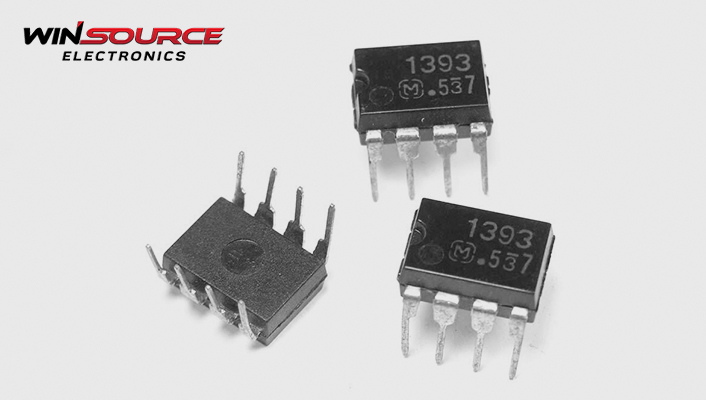
A comparator is an important component widely used in electronic circuits to compare the magnitude relationship of two voltages or signals. Comparators play an important role in many electronic systems, such as analog-to-digital conversion, voltage comparison, voltage detection, etc. This article will provide an in-depth look at how comparators work, the different types of comparators, and their applications in electronics.
Table of Contents
ToggleThe working principle of the comparator
The operating principle of a comparator is based on the concept of voltage comparison. When two input signals are compared by a comparator, the output voltage of the comparator depends on the relative magnitude of the input signals. Two common comparator operating principles are described below.
Amplifier Based Comparator
Amplifier-based comparators take advantage of the high-gain nature of amplifiers to perform voltage comparisons. It usually consists of a differential amplifier and a threshold voltage reference. A differential amplifier takes two input signals, amplifies them, and compares the amplified signals to a reference voltage. If the voltage of the input signal is higher than the reference voltage, the output is high; if the voltage of the input signal is lower than the reference voltage, the output is low. Amplifier-based comparators typically have high gain and a wide input voltage range for precise comparison tasks.
Switch Based Comparator
Switch-based comparators use the switching properties of switching elements, such as transistors, to achieve voltage comparisons. It usually consists of a reference circuit for comparing threshold voltages and a comparator circuit. The comparison circuit compares the input signal with the reference voltage, and outputs a corresponding level state through the control of the switch element. When the voltage of the input signal is higher than the reference voltage, the switch element is turned on and outputs a high level; when the voltage of the input signal is lower than the reference voltage, the switch element is turned off and outputs a low level. Switch-based comparators typically have faster response and lower power consumption, making them suitable for high-speed and low-power applications.
Different types of comparators
According to the different characteristics and application requirements of the comparator, there are many types of comparators. Several common comparator types are described below.
Device Type Comparator
Device Type Comparators are the most common type of comparator and typically use operational amplifiers or switching elements as key components. Among them, the operational amplifier comparator utilizes the amplification and feedback characteristics of the operational amplifier to realize voltage comparison. It features high gain, high accuracy, and a wide input voltage range for precision measurement and control applications. Switching element comparators use switching characteristics of switching elements (such as transistors, MOSFETs, etc.) to achieve voltage comparison. It features fast response and low power consumption, making it suitable for high-speed and low-power applications.
high speed comparator
High-speed comparators are specifically designed for applications that handle high-frequency signals and fast switching. It has fast response speed and low latency, which can accurately capture and process fast changing signals. High-speed comparators usually use high-speed switching elements and optimized circuit design to meet the requirements of high-speed signal processing.
Low Power Comparator
The low-power comparators are designed to reduce power consumption and extend battery life. It employs low power switching elements and an optimized circuit design to minimize power dissipation and quiescent current consumption. Low-power comparators are often used in power-hungry applications such as portable devices, wireless sensor networks, and battery-powered systems.
Accuracy Comparator
Precision comparators are used for precise comparison and measurement of input signals. It features high gain accuracy, low offset, and low noise to ensure accurate comparison results. Precision comparators are commonly used in applications such as precision measurements, analog-to-digital conversion, and automatic control systems.
The application of the comparator
Comparators have a wide range of applications in electronics. Here are a few common application examples:
Analog-to-Digital Converter (ADC): A comparator is used in the ADC for the comparison between the analog voltage and the reference voltage. It converts an analog input signal to a digital output for precise analog-to-digital conversion.
Voltage Sensing and Threshold Triggering: Comparators can be used in applications such as supply voltage sensing, overvoltage protection, and undervoltage protection. By comparing with the set threshold voltage, the comparator can trigger the corresponding action or alarm.
Circuit Control and Switching: Comparators can be used to control switches and flip-flops in circuits. According to the comparison result of the input signal, the comparator can control the state of the switch and flip-flop to realize the control and switching operation of the circuit.
Pulse Width Modulation (PWM): A comparator can be used to generate a PWM signal to adjust the pulse width of the output signal by comparing the input signal with a reference voltage for applications such as controlling motor speed, dimming, and power management.
Flip-Flops and Sequential Circuits: Comparators can be used for comparison operations in flip-flops and sequential circuits. It can judge the state of the input signal, trigger the corresponding sequence operation, and realize specific logic function and sequence control.
Sensor signal processing: Comparators can be used to process sensor signals, such as temperature sensors, light sensors, and pressure sensors. By comparing with the set reference voltage, the comparator can judge the magnitude and state of the sensor signal, and trigger the corresponding operation or feedback.
To sum up, the comparator, as an important electronic component, plays a key role in many applications. By enabling voltage comparison and signal processing, comparators can provide precise and reliable functions in areas such as analog-to-digital conversion, circuit control, pulse width modulation, and sensor signal processing. With the continuous development of technology, the performance and functions of the comparator are continuously improved to meet the needs of different application scenarios. Therefore, it is very important for electronic engineers and technical practitioners to have a deep understanding of the principles and applications of comparators.

COMMENTS